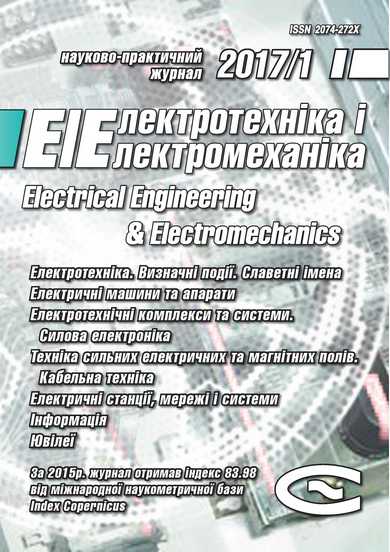WAYS TO IMPROVE THE EFFICIENCY OF COMPUTER SIMULATION OF ELECTRICAL SYSTEMS MODES BASED ON EQUATIONS IN PHASE COORDINATES
DOI:
https://doi.org/10.20998/2074-272X.2017.1.10Keywords:
stationary modes, electric networks, mathematical models, phase coordinates, transientsAbstract
The development of electrical systems must be accompanied by the development of tools and their modeling. However, the possibility of development models, traditionally developed on the basis of the transition from the real to the single-phase three-phase circuits equivalents, represented exhausted. Therefore, along with the use of single-phase three-phase equivalents need to develop models in phase coordinates. Showing the need to move to the development of models based on equations in the phase coordinates and the possibility of increasing the effectiveness of development through the use of implicit methods of integration, the transition to a higher level of decomposition and unification models developed for the implementation of the structural approach to modeling complex systems.References
1. Golov P.V., Sharov Yu.V., Stroyev V.A. System of mathematical models for the calculation of transients in complex power systems. Electricity, 2007, no.5, pp. 2-11. (Rus).
2. Misrikhanov M.Sh. Clarification of the definition of places of damage to overhead lines by using the phase components. Electric stations, 2001, no.3, pp. 36-40. (Rus).
3. Vepryk Yu.N. Komp'iuternoe modelirovanie rezhimov raboty elektricheskikh sistem: monografiia [Computer simulation of electrical systems modes: monograph]. Kharkiv, NTU «KhPI» Publ., 2015. 304 p. (Rus).
Downloads
Published
How to Cite
Issue
Section
License
Copyright (c) 2017 Yu. M. Vepryk

This work is licensed under a Creative Commons Attribution-NonCommercial 4.0 International License.
Authors who publish with this journal agree to the following terms:
1. Authors retain copyright and grant the journal right of first publication with the work simultaneously licensed under a Creative Commons Attribution License that allows others to share the work with an acknowledgement of the work's authorship and initial publication in this journal.
2. Authors are able to enter into separate, additional contractual arrangements for the non-exclusive distribution of the journal's published version of the work (e.g., post it to an institutional repository or publish it in a book), with an acknowledgement of its initial publication in this journal.
3. Authors are permitted and encouraged to post their work online (e.g., in institutional repositories or on their website) prior to and during the submission process, as it can lead to productive exchanges, as well as earlier and greater citation of published work.





